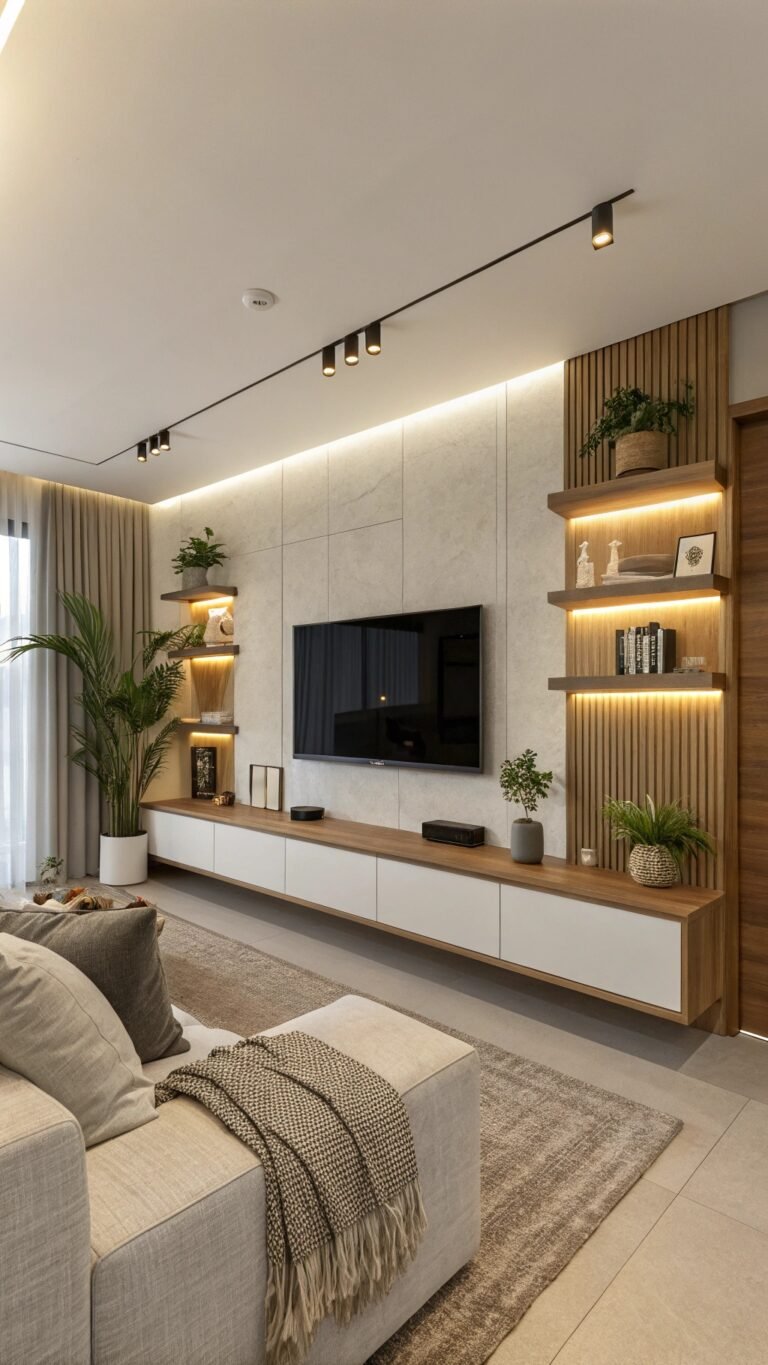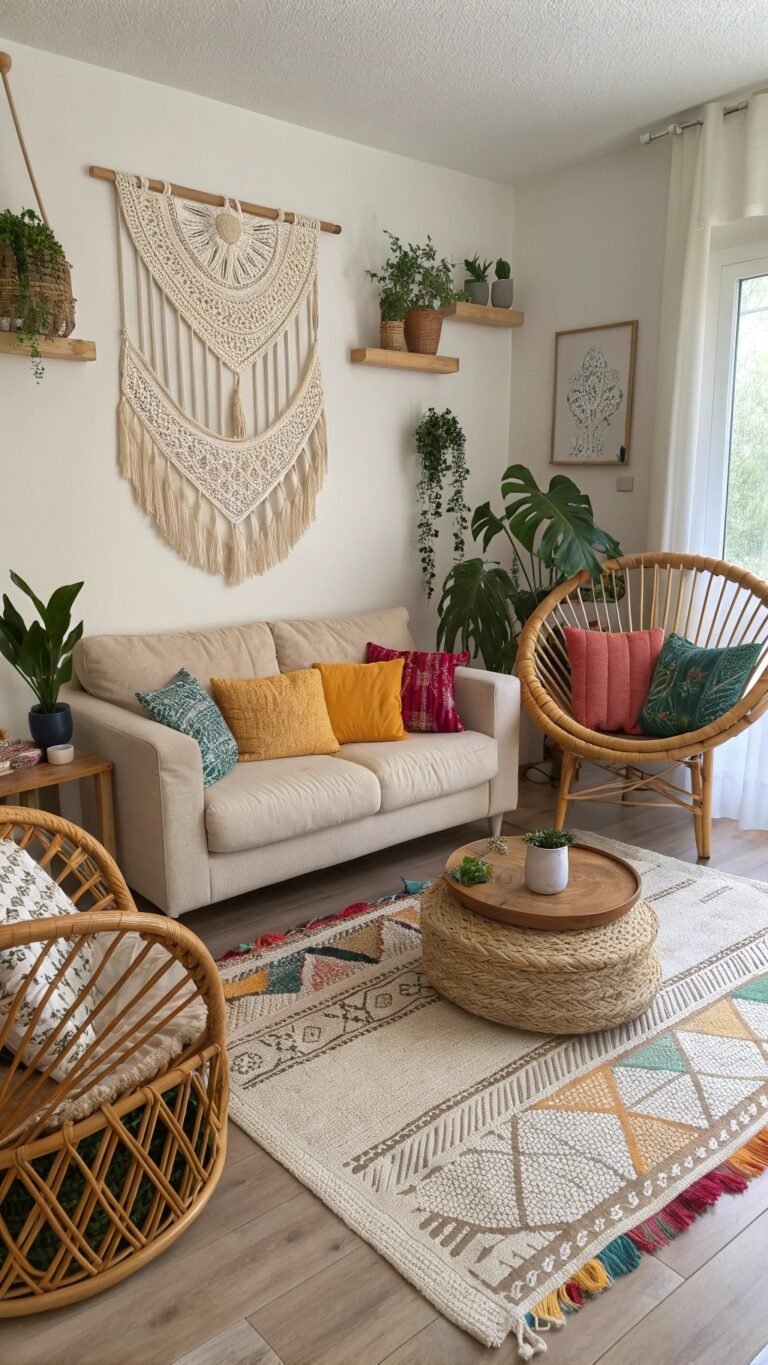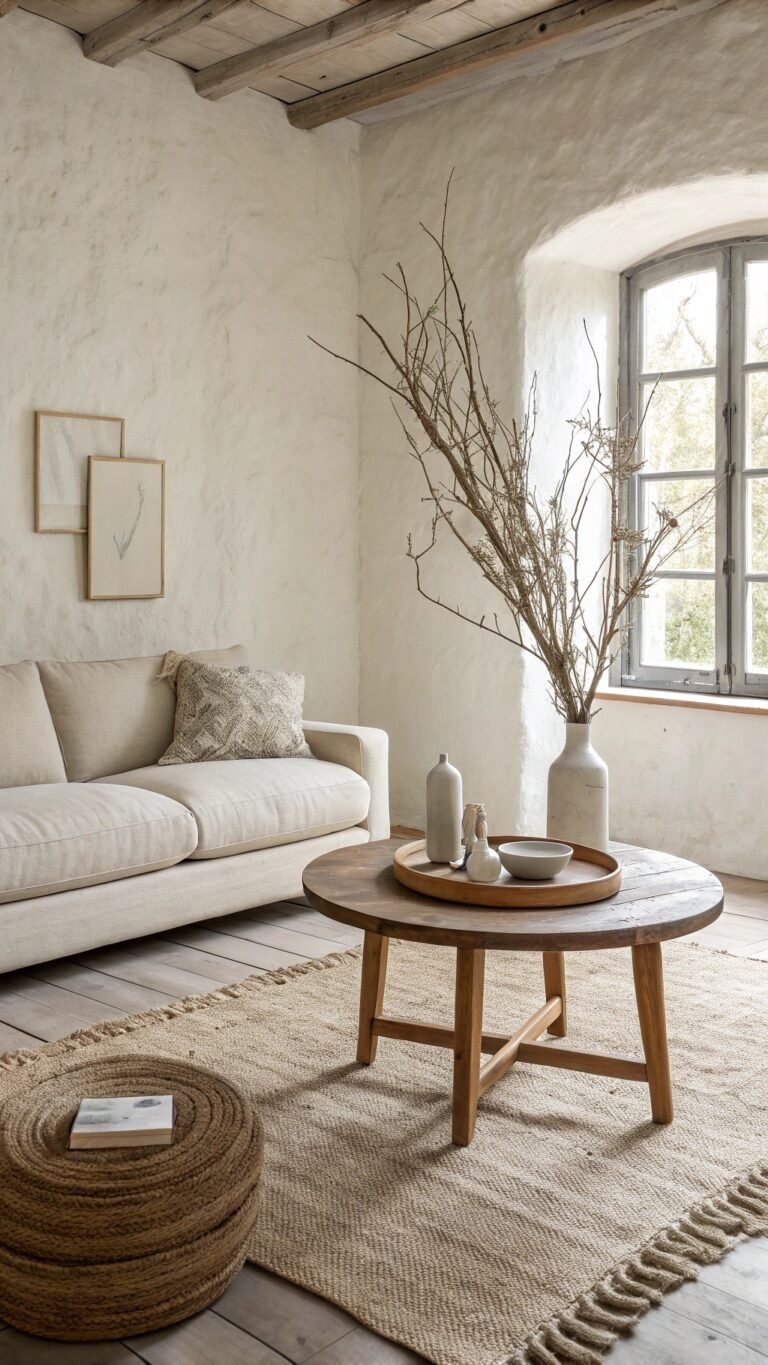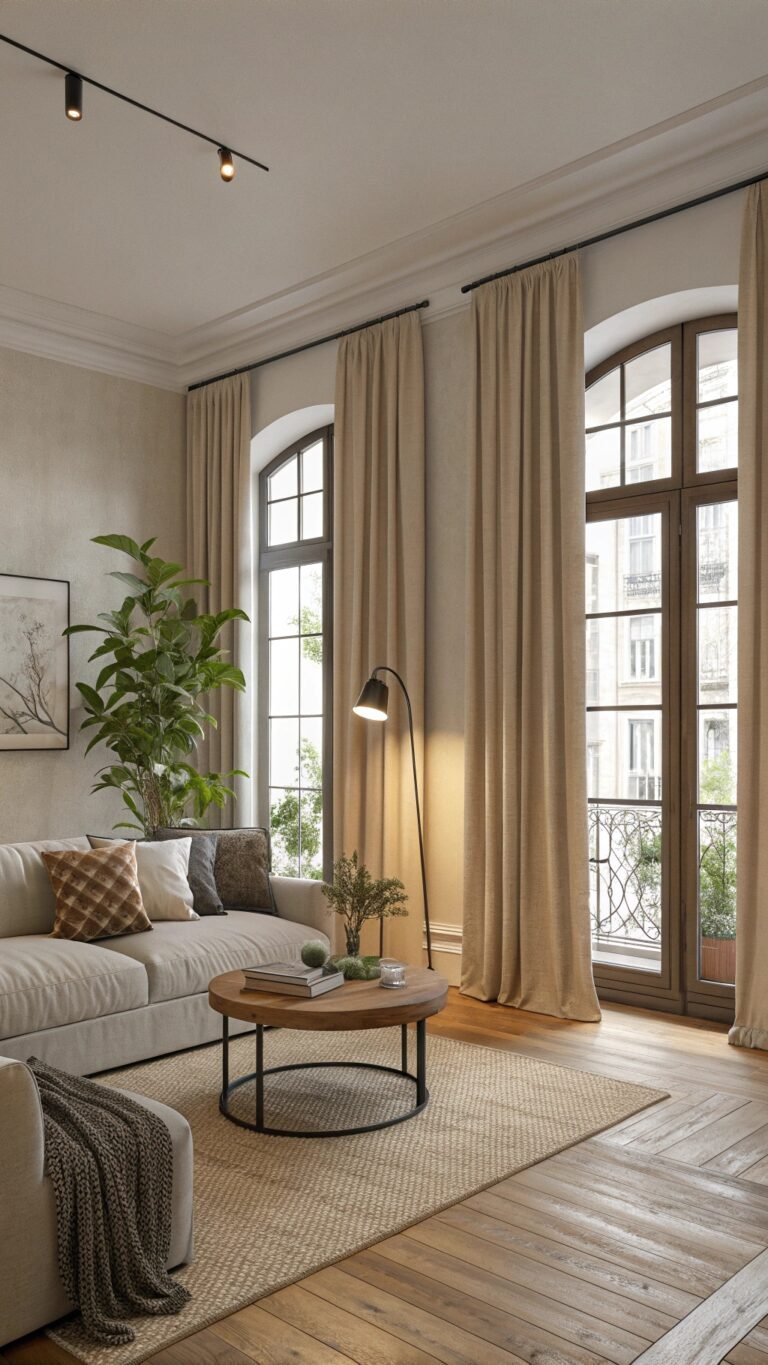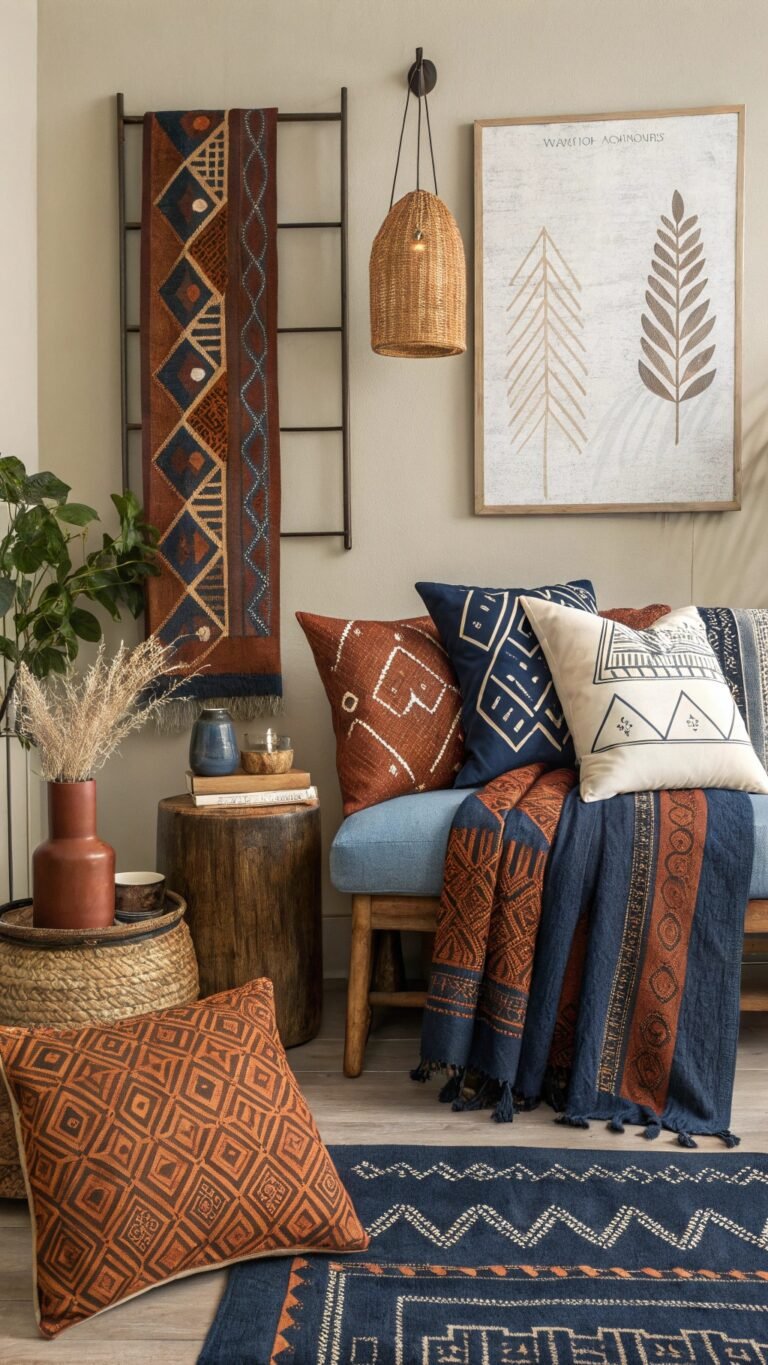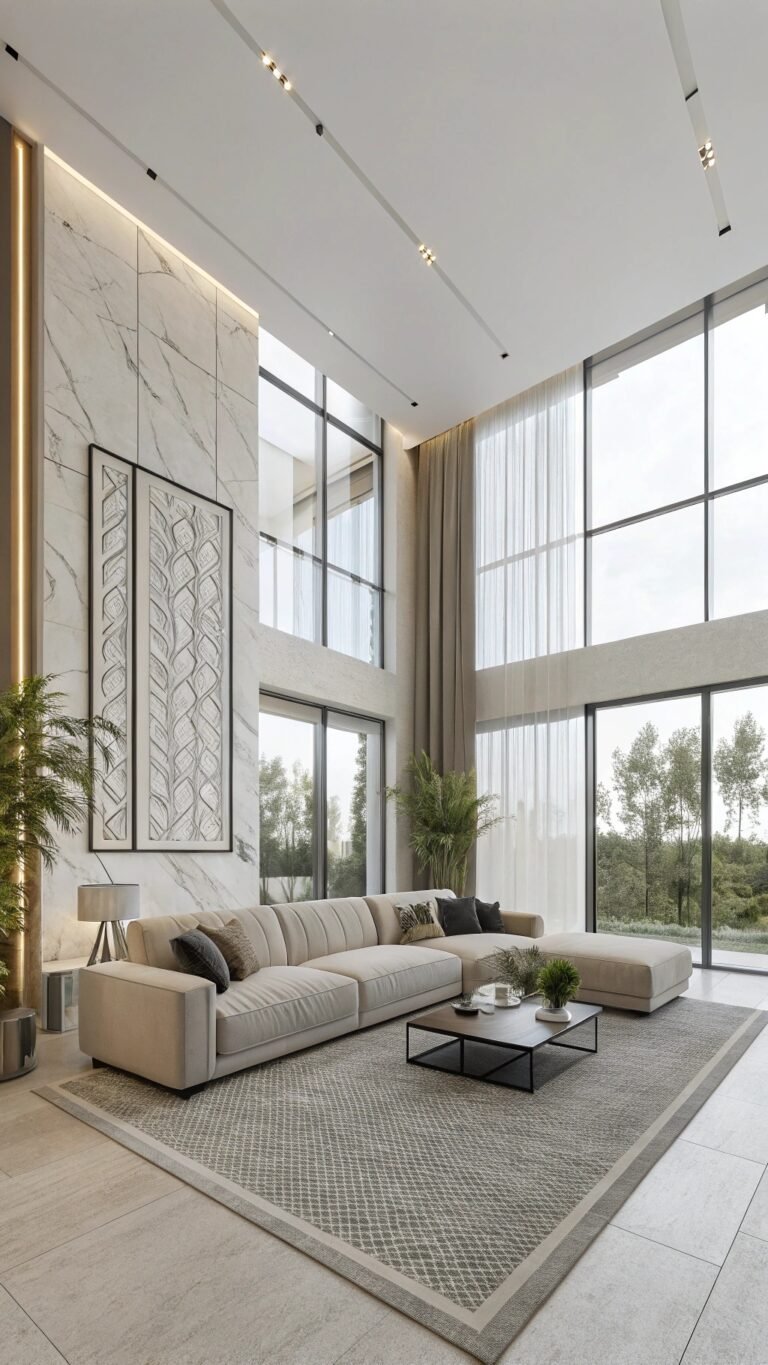18 Interior Design Living Room Ideas for a Stylish and Functional Space
“Interior design living room” is the must-try trend because people want spaces that perform beautifully on busy days and photograph elegantly on quiet nights. The look combines smart layouts, layered lighting, sustainable materials, and refined textures.
It’s less about collecting things and more about curating harmony—calming palettes, sculptural lines, and storage that quietly disappears.
1) Tonal Neutrals with Sculptural Forms
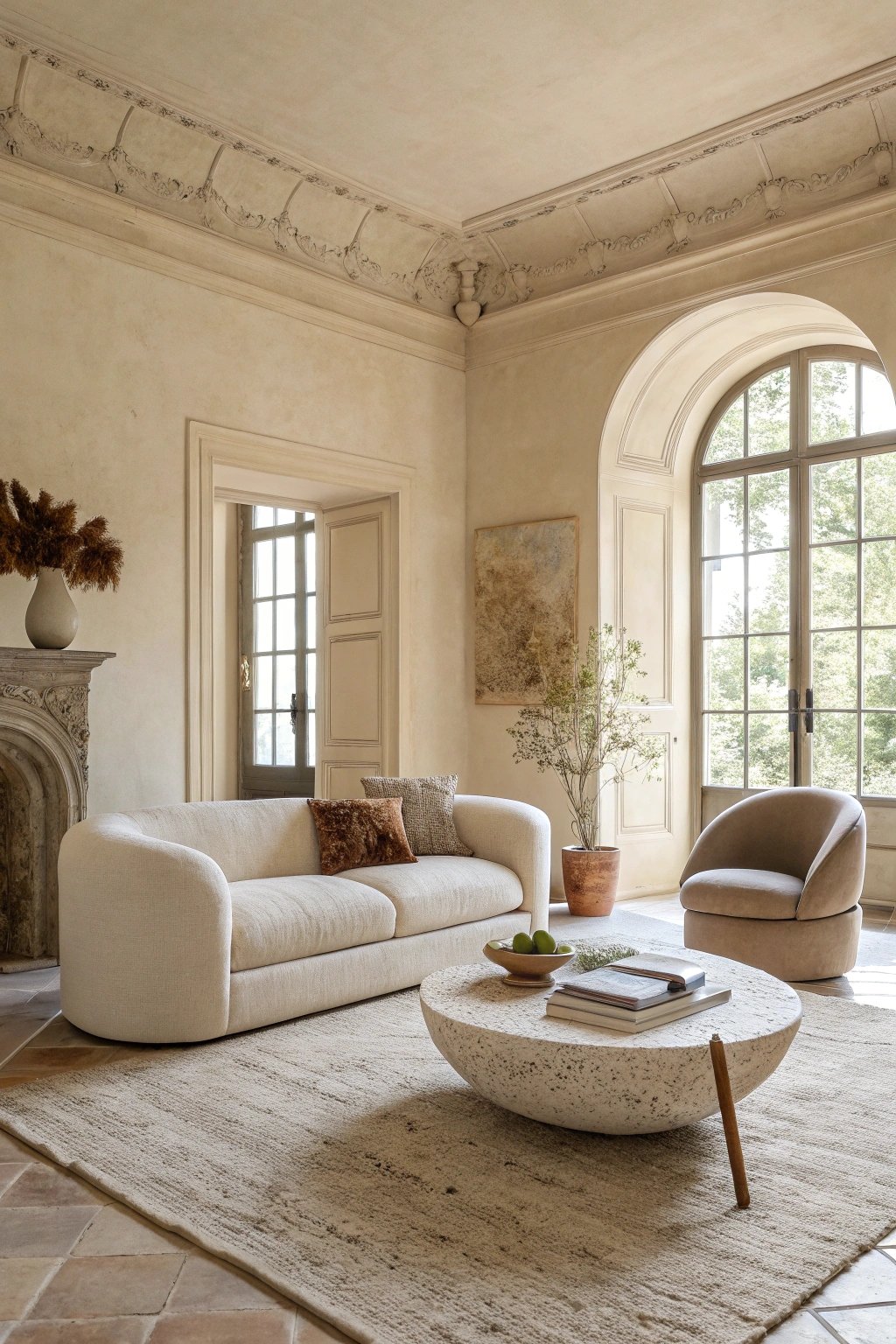
Tonal neutrals—ivory, oat, greige, mushroom—create a calm foundation where form and texture lead. A low-profile sofa, rounded lounge chair, and softly curved coffee table keep the eye moving without visual noise.
Limit the palette to three or four shades and let materials—bouclé, tight-loop wool, honed stone—deliver depth. The result feels tailored, timeless, and effortlessly restful.
What makes something unique
Work with finish contrast rather than adding color: matte limewash walls, a wool-silk rug with a subtle sheen, and a bouclé accent chair.
Repeat one slender metal detail—brushed brass or blackened steel—across lamp stems, picture frames, and pulls to create quiet rhythm. This disciplined restraint makes the interior design living room read cohesive and custom.
2) Modern Classic: Molding Meets Minimal
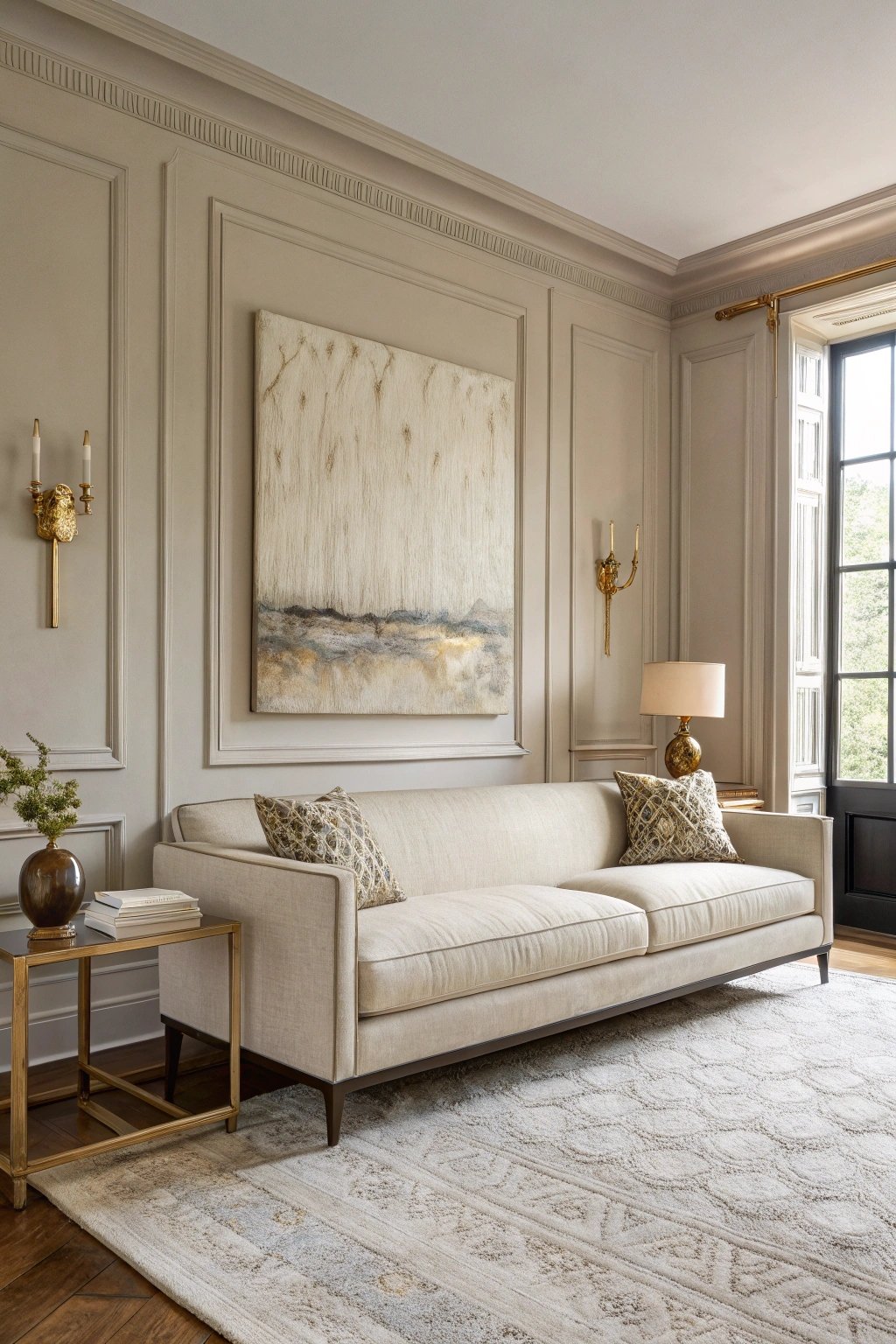
Picture-frame molding and crisp, contemporary furniture create an elegant dialogue. Paint walls, trim, and molding the same hue for a monolithic envelope, then introduce a tailored sofa, slim metal lighting, and a single large artwork.
The classic lines add gravitas while modern silhouettes keep the room fresh and uncluttered.
What makes something unique
Use tone-on-tone paint with a subtle sheen shift—matte walls, satin molding—to catch light. Specify a wool rug with a faint geometric to echo the molding grid.
Brass swing-arm sconces flanking art add gallery polish. This blend of old and new gives the interior design living room couture calm without stiffness.
3) Japandi Serenity
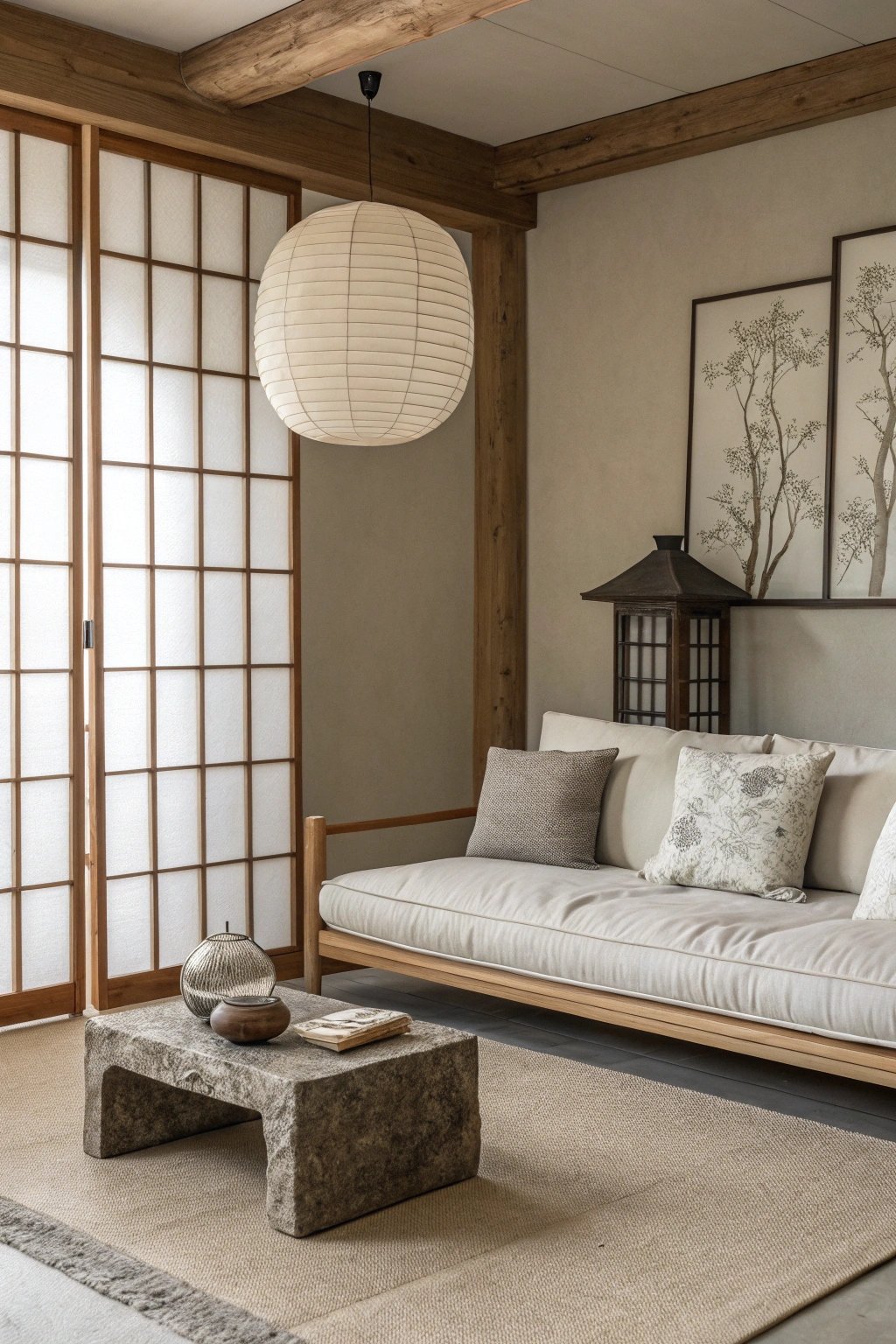
Japandi merges Scandinavian warmth with Japanese restraint. Keep furniture low and honest in pale oak with linen upholstery. Use a tight palette and integrate concealed storage so surfaces stay open.
A paper pendant and shoji-inspired screen add softness while admitting filtered light. The atmosphere encourages slow routines and quiet conversation.
What makes something unique
Limit finishes to light wood, matte stone, and black accents for clarity. Choose one hand-thrown ceramic or carved stool to introduce wabi-sabi imperfection.
A linen curtain panel mounted high elongates walls without weight. The intentional absence of clutter makes the interior design living room feel grounded and deeply restorative.
4) Mid-Century Streamlined Warmth
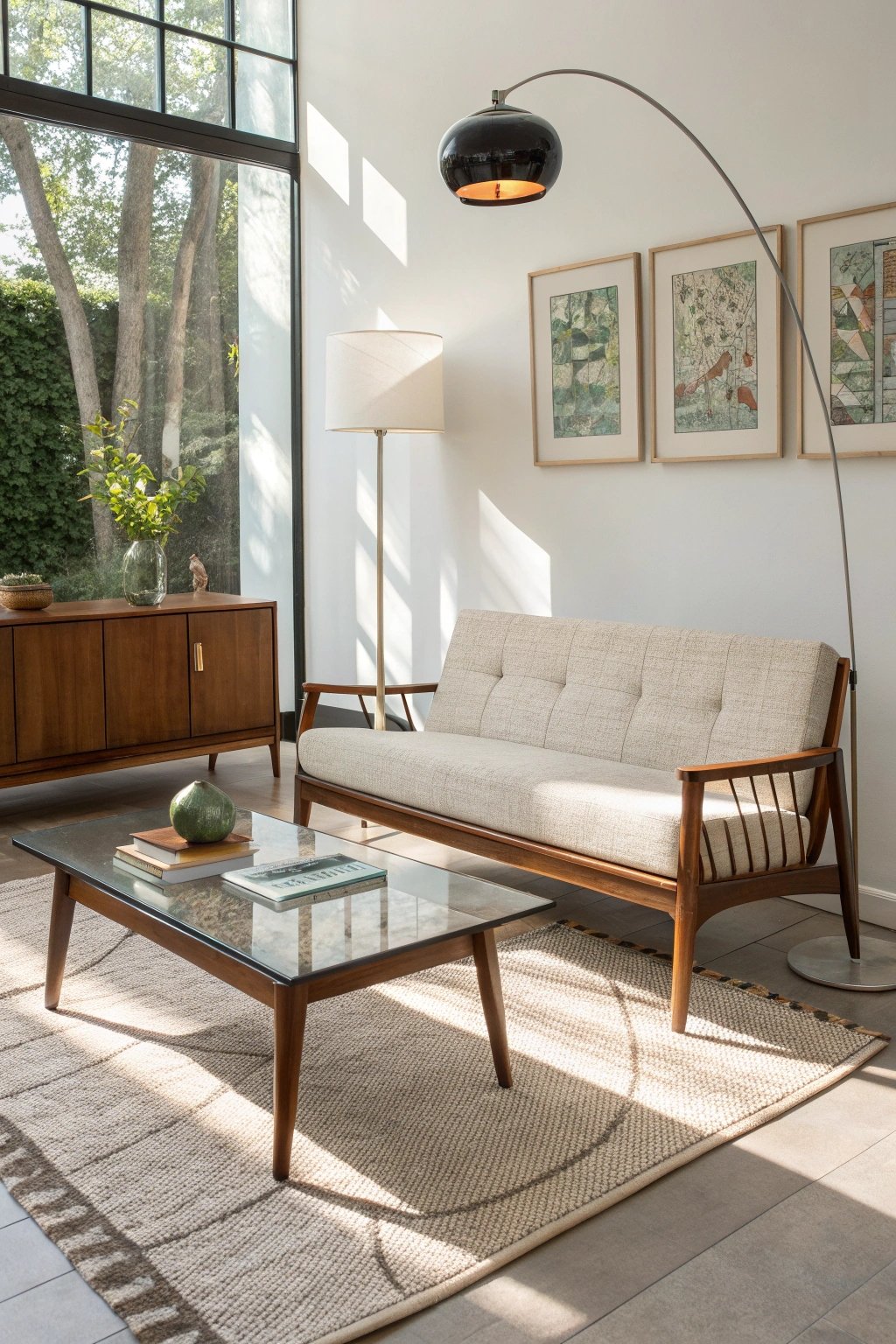
Mid-century lines read eternally modern. A bench-seat sofa, tapered wood legs, and a walnut credenza keep proportions crisp. Anchor with a graphic wool rug and a dome floor lamp.
Keep surfaces edited—one sculptural vase, a stack of design books—so the heritage forms shine instead of feeling themed.
What makes something unique
Balance vintage pieces with new textiles in contemporary weaves for freshness. Choose a low-iron glass coffee table to reveal the rug geometry beneath.
Repeat walnut in three places—frame, credenza, side table—for cohesion. This approach delivers a respectful nod to history while serving today’s interior design living room needs.
5) Industrial Soft Loft
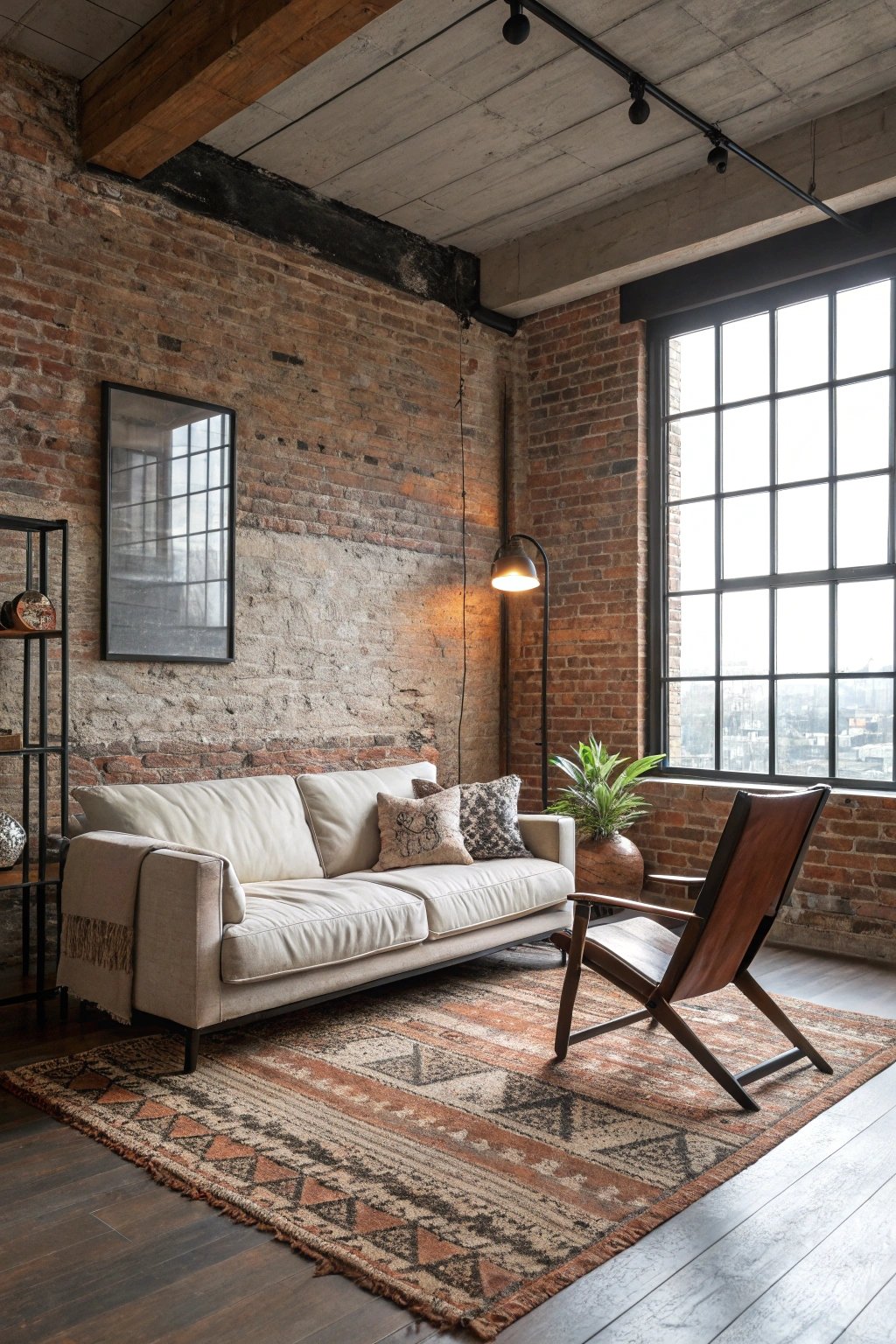
Exposed brick or concrete provides character; soft textiles and rounded furniture bring comfort. Black-framed lighting and artwork add structure, while warm wood tones and linen drapery prevent coldness.
Keep the plan open and the palette tight so architecture leads and accessories support rather than compete.
What makes something unique
Introduce one luxe texture—cashmere throw, leather sling chair, or mohair cushion—to counterbalance raw surfaces. Layer rugs (flatweave over jute) to zone seating.
Track lighting with dim-to-warm bulbs creates gallery glow at night. The combination turns an industrial shell into an inviting interior design living room.
6) Coastal Light & Airy
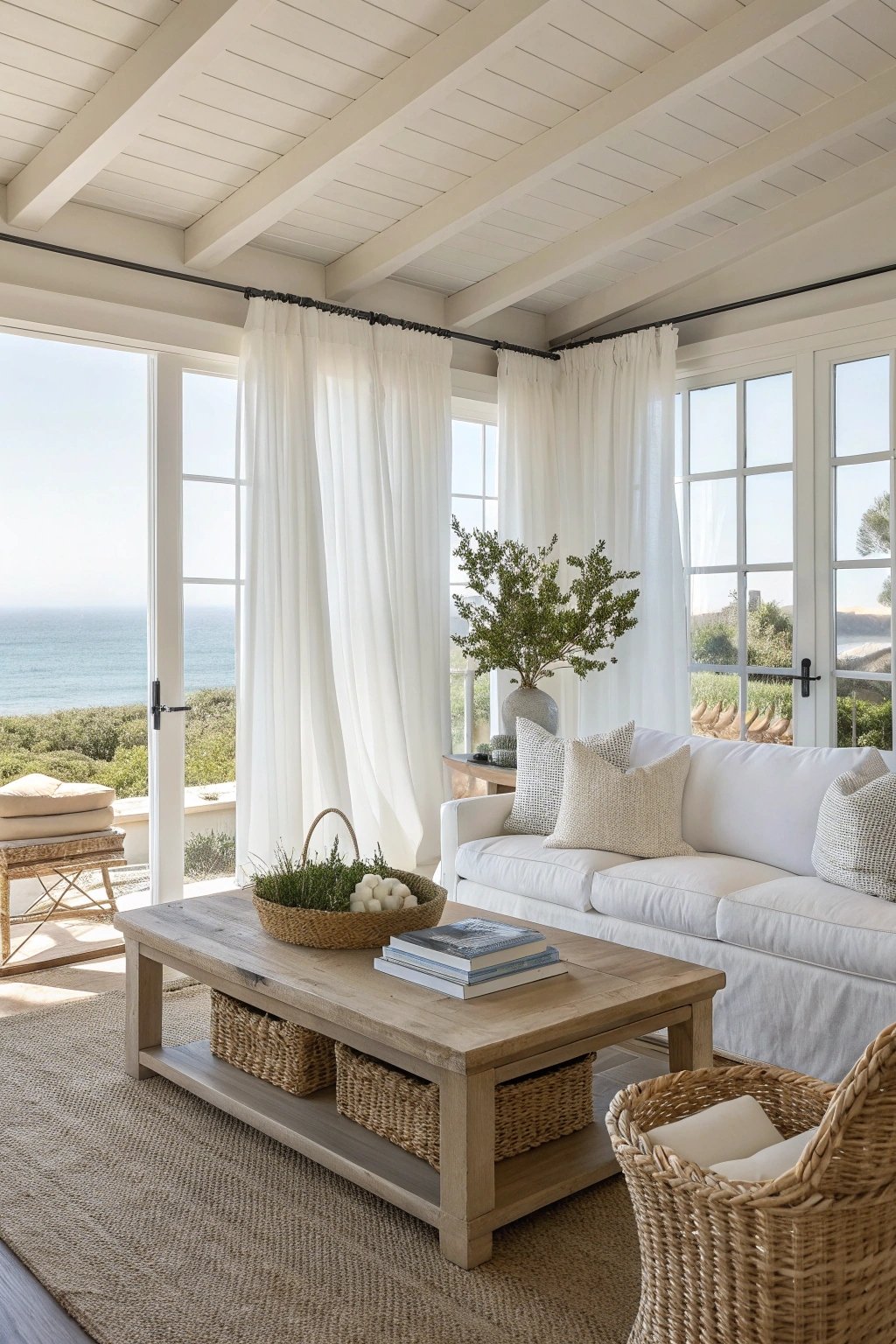
Coastal modern favors breezy textures and clarity: white walls, gauzy curtains, seagrass baskets, and bleached woods.
Keep patterns delicate—pinstripes and fine checks—and accent with sea-glass hues in glassware or cushions. The room feels bright, optimistic, and easy to maintain without beach-house clichés.
What makes something unique
Use a capiz or rattan pendant to scatter soft light. Choose two blues max and repeat them intentionally. A driftwood-framed mirror and shell dish create a restrained vignette.
The delicate hand of materials gives the interior design living room freshness without sacrificing sophistication.
7) Dark & Moody Luxe
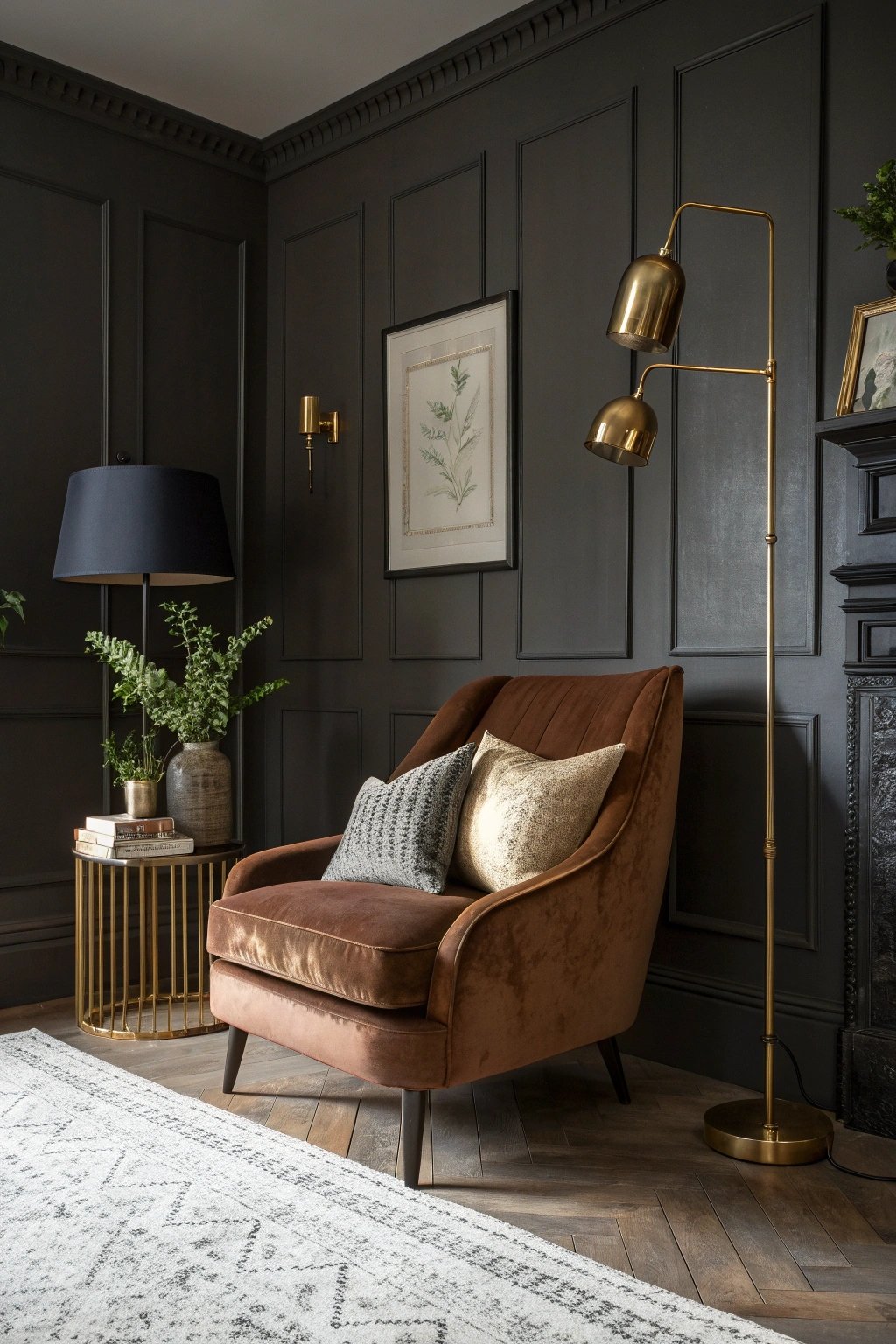
Charcoal walls, espresso wood, and smoked glass create a cocooning mood. Use velvet in small doses for sheen and keep metals warm—brass or bronze—to glint against the darkness.
A plush rug and layered lamps tame acoustics and provide a cinematic atmosphere suited to late-night lounging.
What makes something unique
Balance weight with glow: alabaster lamps, ribbed glass pendants, and picture lights washing art. Keep bedding-like textiles—sateen cushions, cashmere throws—in pale tones for contrast.
Dimmer-controlled scenes shift from dramatic to restful. This moody palette adds depth to the interior design living room without feeling oppressive.
8) Color-Block Geometry
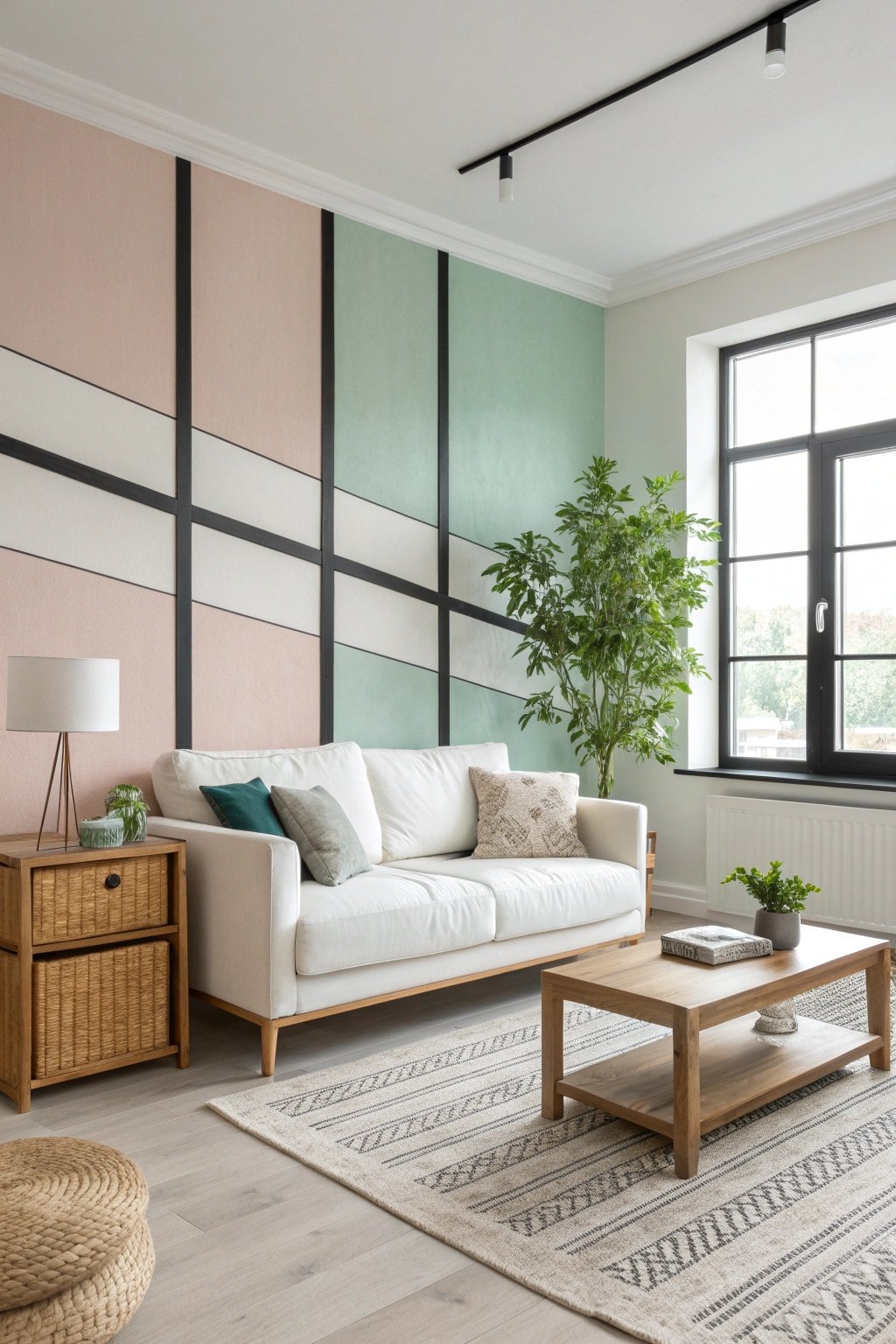
Large fields of color sculpt space without clutter. Paint a head-height band or wrap a corner in two pastels plus one grounding neutral.
Pair with simple furniture so the architecture of color takes the lead. This technique is inexpensive, reversible, and high impact for renters and owners alike.
What makes something unique
Repeat each color at least twice and keep lines crisp—use laser levels and painter’s tape. Add a single black stripe or metal reveal for definition.
Pair with white bedding-like textiles on the sofa to keep the composition airy. The graphic clarity modernizes the interior design living room instantly.
9) Biophilic Greenery & Organic Forms
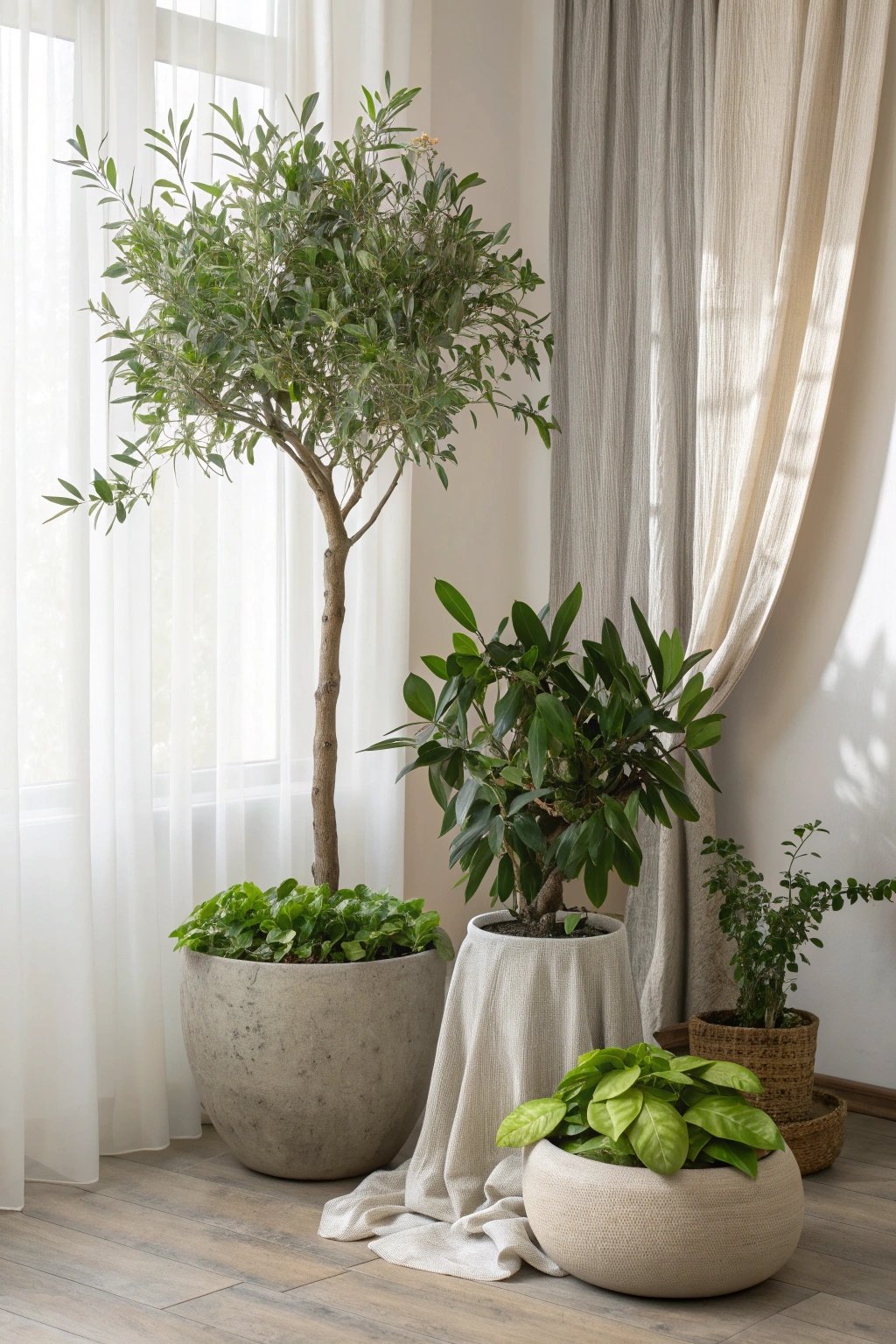
Plants soften geometry and boost wellbeing. Combine a tall sculptural tree with mid-height foliage and a trailing vine on shelves.
Keep planters in matte ceramic or stone to align with the room’s materials. Organic silhouettes in tables and lamps echo leaf forms for a cohesive, calming rhythm.
What makes something unique
Use a discreet grow light behind larger pots to sustain health without visible tech. Group plants in odd numbers and vary leaf sheen for depth.
A pebble tray adds humidity and styling interest. This living layer enlivens the interior design living room without adding visual clutter.
10) Layered Lighting: Ambient, Task, Accent
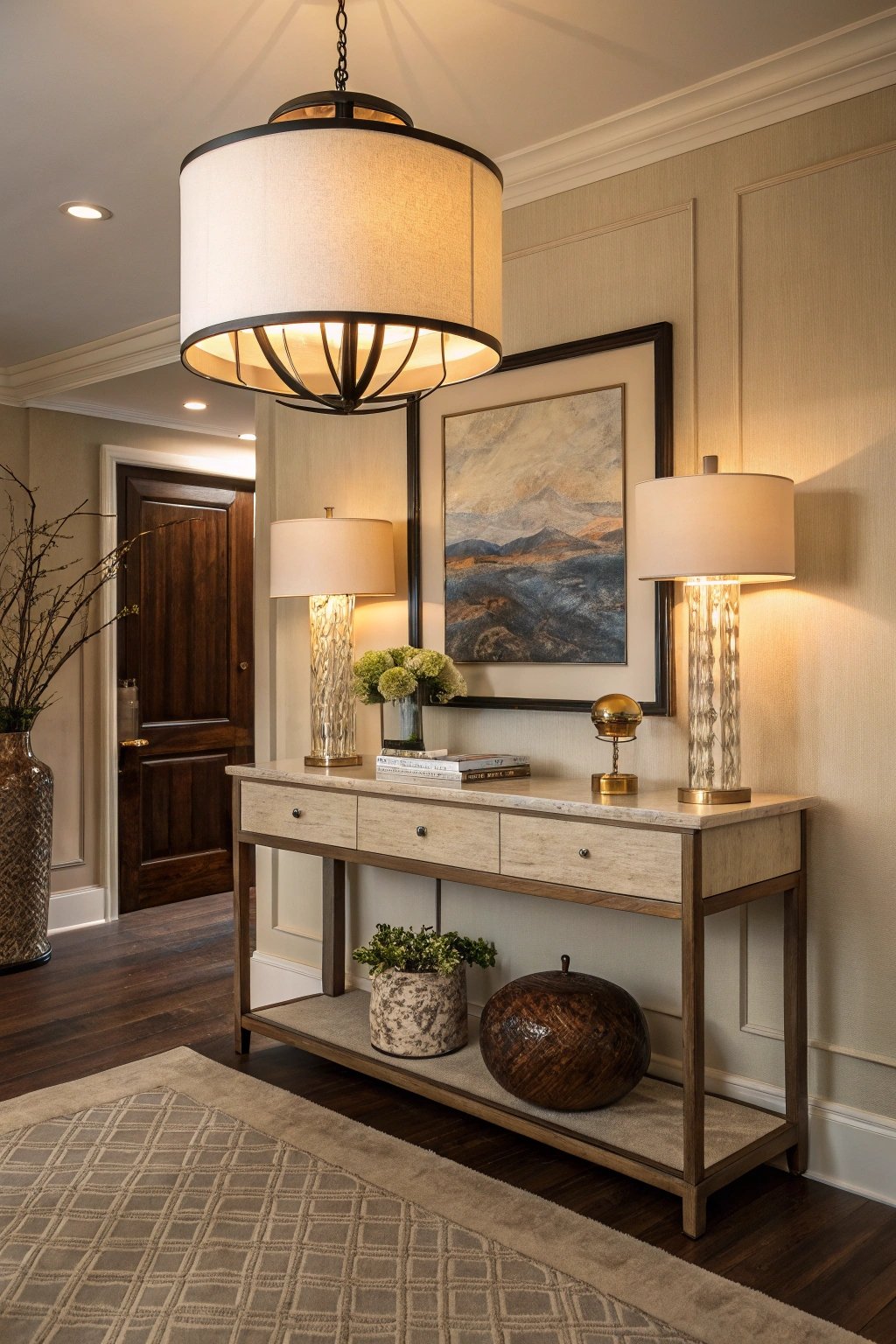
Design for glow, not glare. Combine a ceiling pendant or cove for ambient, floor or swing-arm lamps for reading, and picture or shelf lights for texture.
Keep bulbs warm (2700–3000K) and place each circuit on a dimmer to sculpt mood throughout the day.
What makes something unique
Coordinate fixture finishes but vary forms—linen drum overhead, razor-thin sconces, alabaster table lamps. Add toe-kick LEDs under a floating console for a subtle halo.
Consistent color temperature across sources creates coherence. Smart scenes (Read, Unwind, Entertain) elevate the interior design living room experience.
11) Media Wall with Hidden Tech
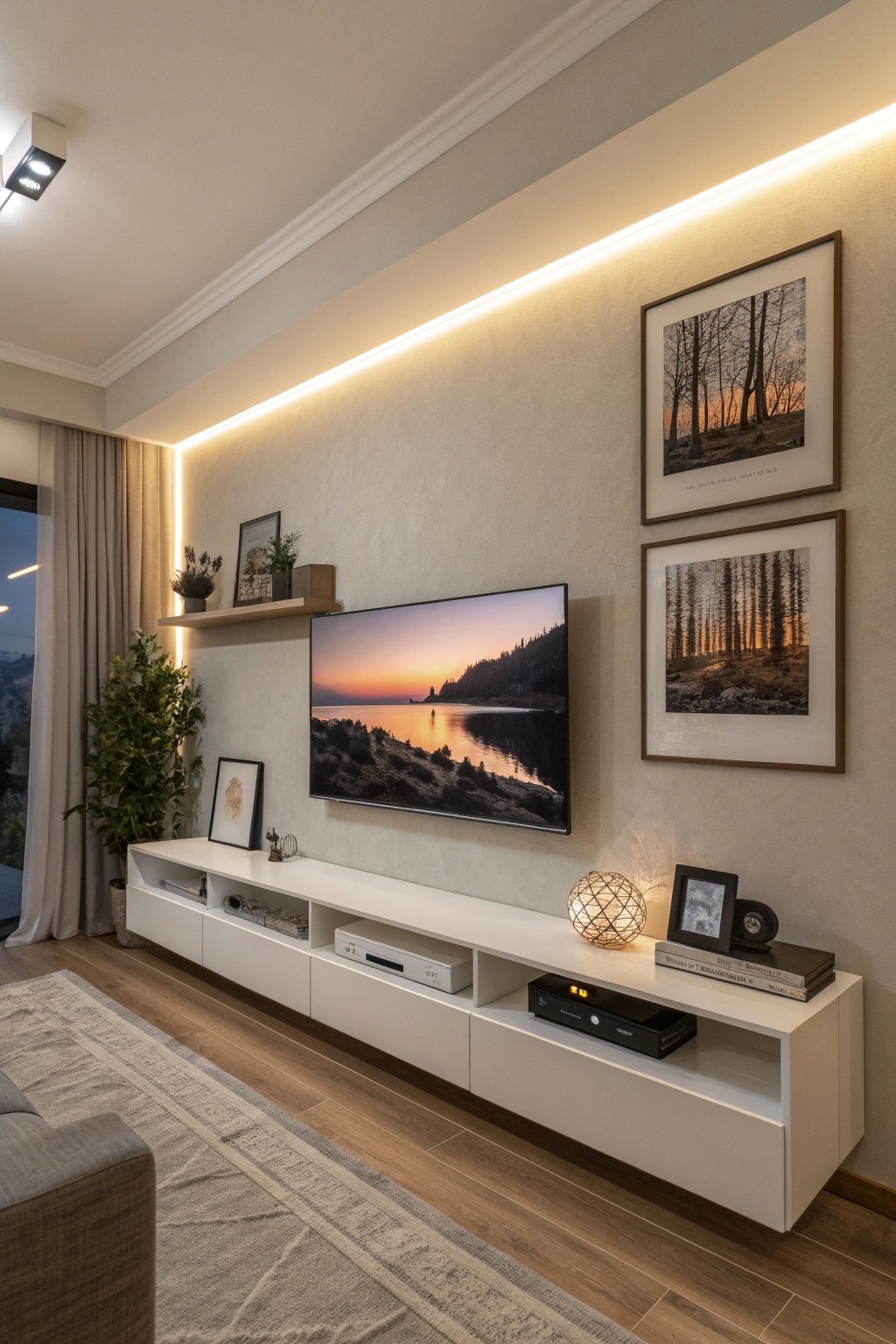
Tame screens and cables. A floating console with vented doors hides components; a frame-style display doubles as art.
A color-matched cable channel or in-wall conduit keeps lines clean. Leave negative space around the screen so the composition reads intentional, not improvised.
What makes something unique
Recess a slim shelf above the display for a picture light or discreet sculpture. Program a rotating art gallery matching the room’s palette.
Add a soundbar wrapped in fabric that echoes textiles. This keeps the interior design living room elegant while fully functional.
12) Curves & Arches for Flow
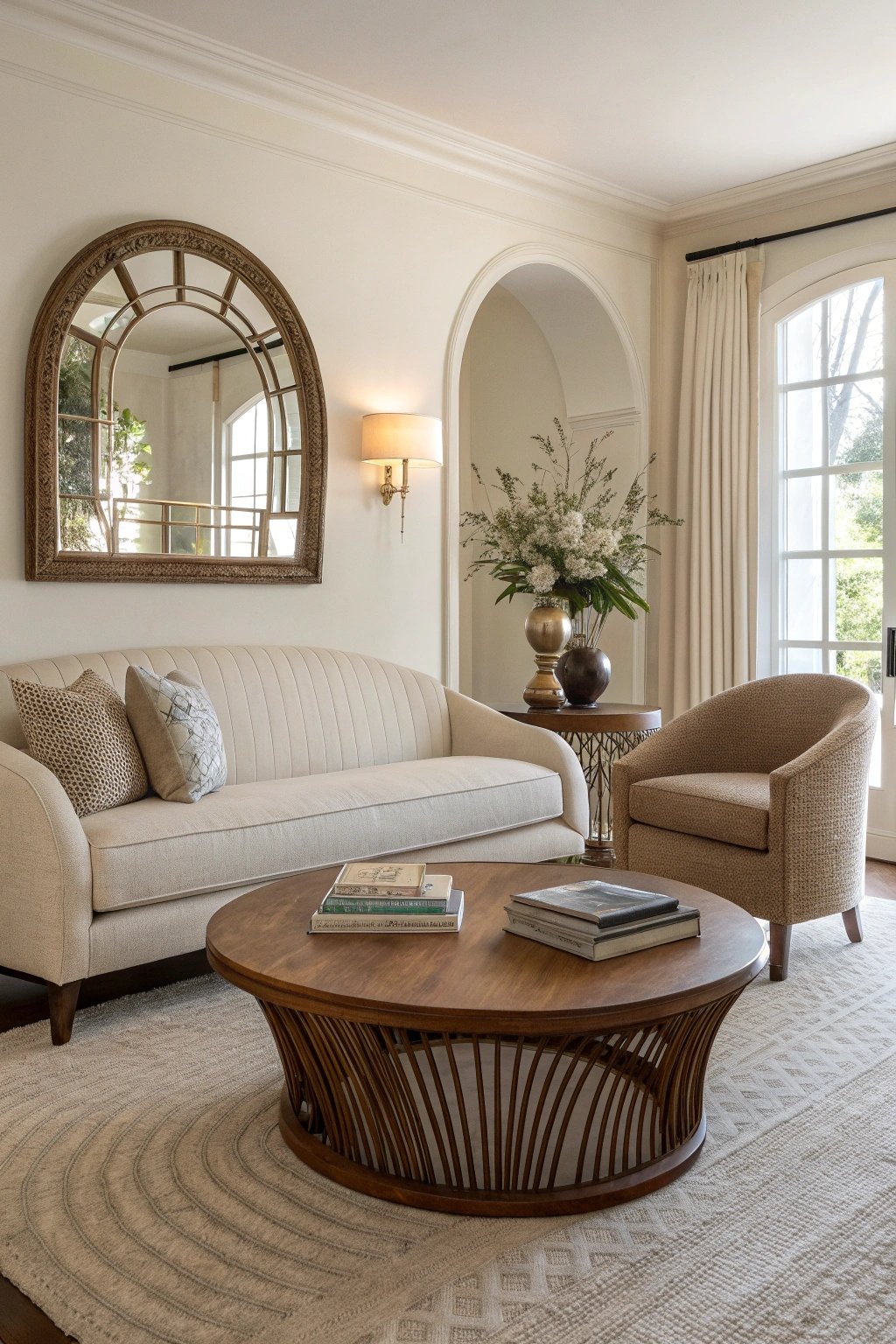
Arcs soften boxy rooms and improve circulation. A round coffee table prevents corner collisions, while an arched mirror or lamp shade adds sculptural lift.
Use curves sparingly as punctuation so they read graceful, not gimmicky, and ensure heights align with sofa arms for visual harmony.
What makes something unique
Repeat one radius across two or three objects—the table, mirror, and lamp dome—to create a subtle rhythm. Pair with a straight-lined sofa for balance.
Curved silhouettes also photograph larger, visually reducing bulk in tight plans. This geometry quietly organizes the interior design living room.
13) Material Story: Stone, Wood, Metal, Glass
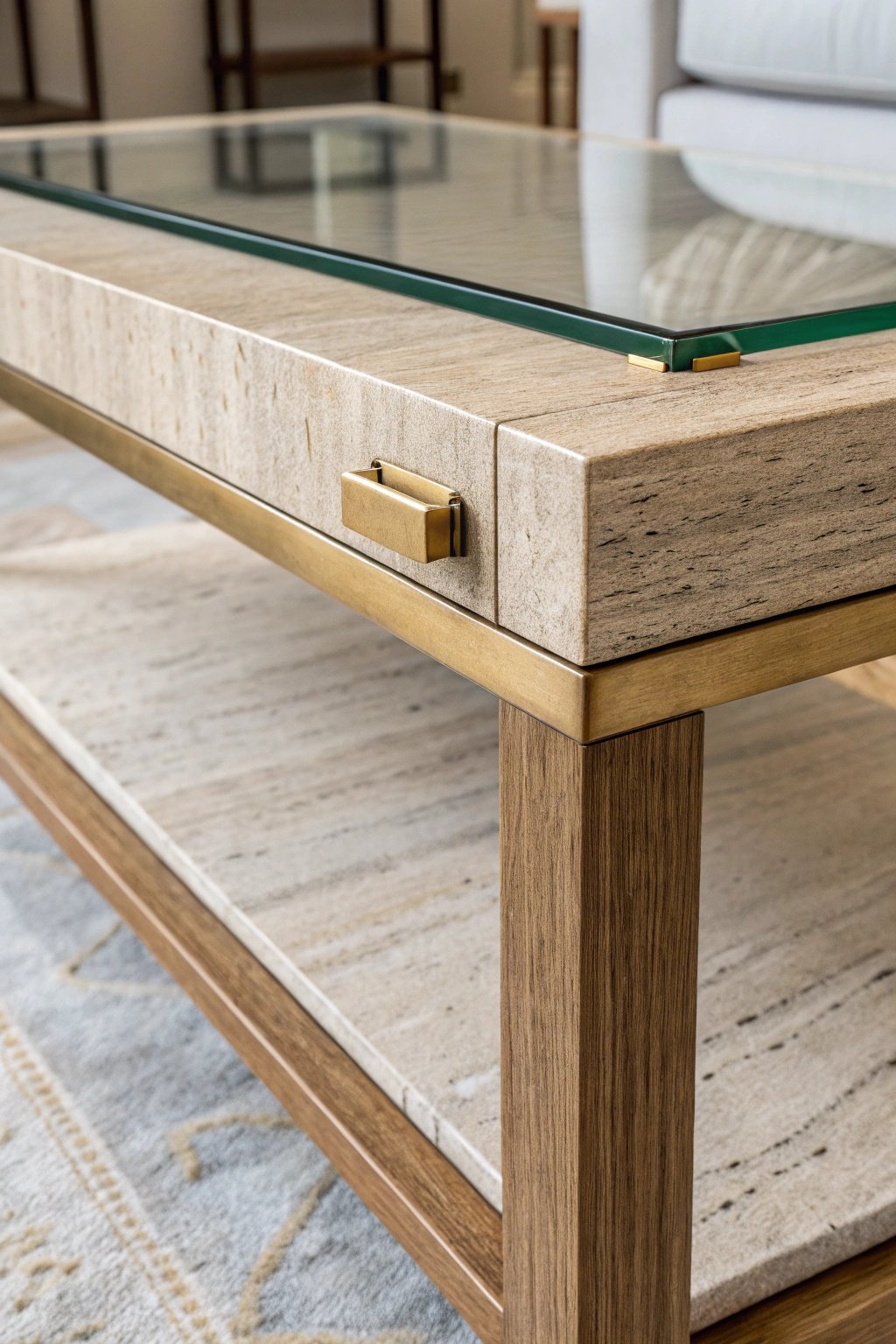
A refined mix of materials is the backbone of modern elegance. Combine honed stone, rift-sawn oak, brushed brass, and low-iron glass.
Keep profiles thin and edges eased; continue wood grain across cabinet fronts. Repeat each material at least three times to establish rhythm and cohesion.
What makes something unique
Introduce one surprise texture—reeded glass, cane, or patinated bronze—for depth without extra color. Align metal finishes across hardware and lighting for unity.
The disciplined palette ensures the interior design living room feels timeless, tactile, and quietly luxurious.
14) Apartment-Smart Layout
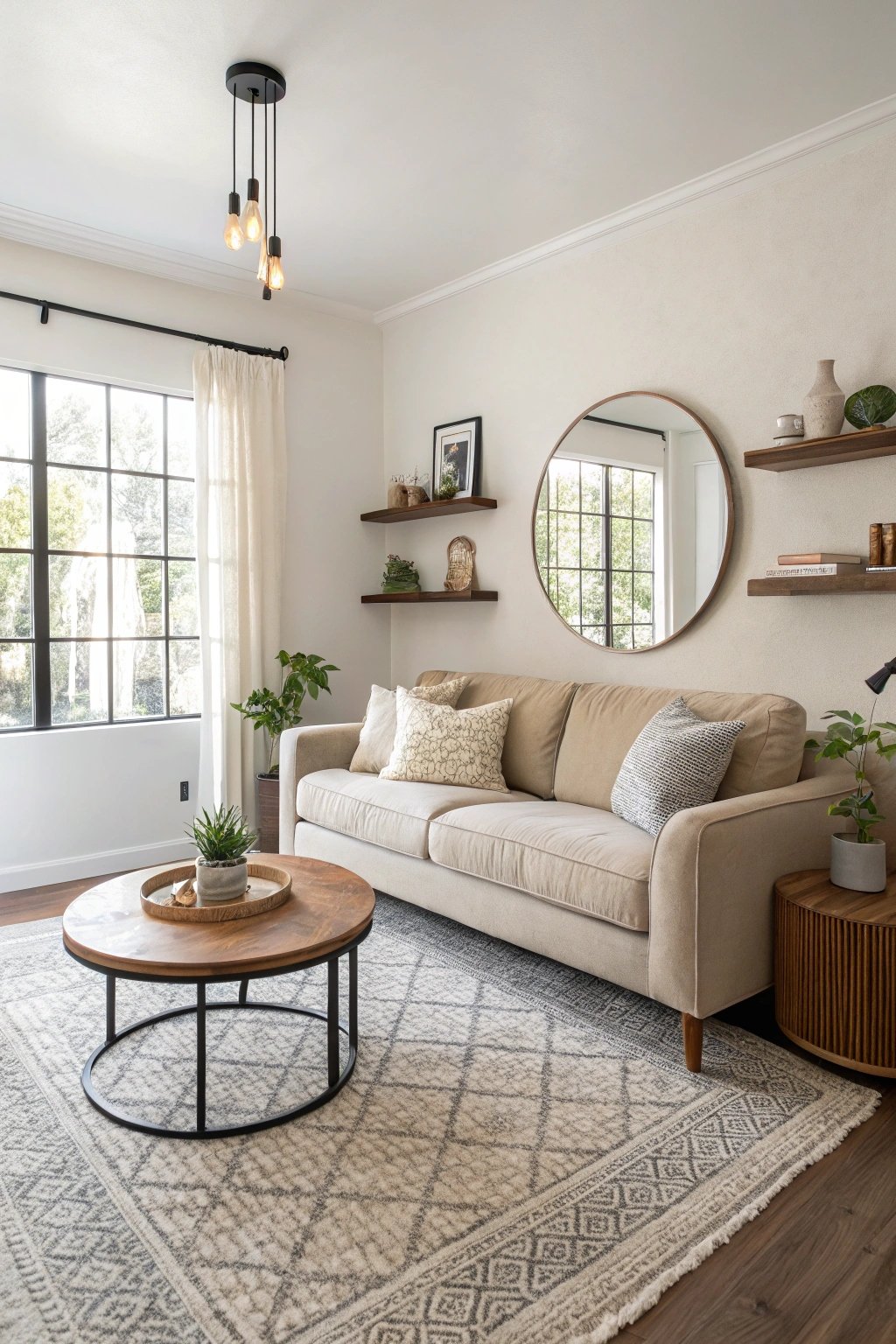
Compact rooms thrive on precision. Select an apartment-length sofa (70–80 inches), float a slim console behind it if walls are scarce, and mount sconces to free tabletops.
Mirrors and light curtains bounce daylight, while a large rug that extends beyond the seating makes the plan read larger.
What makes something unique
Choose dual-purpose pieces: a lift-top coffee table for work, nesting side tables for guests, and a storage ottoman for blankets.
Color-match wardrobes or bookcases to walls so tall storage disappears. The interior design living room feels intentional and airy in limited square footage.
15) Family-Friendly Performance
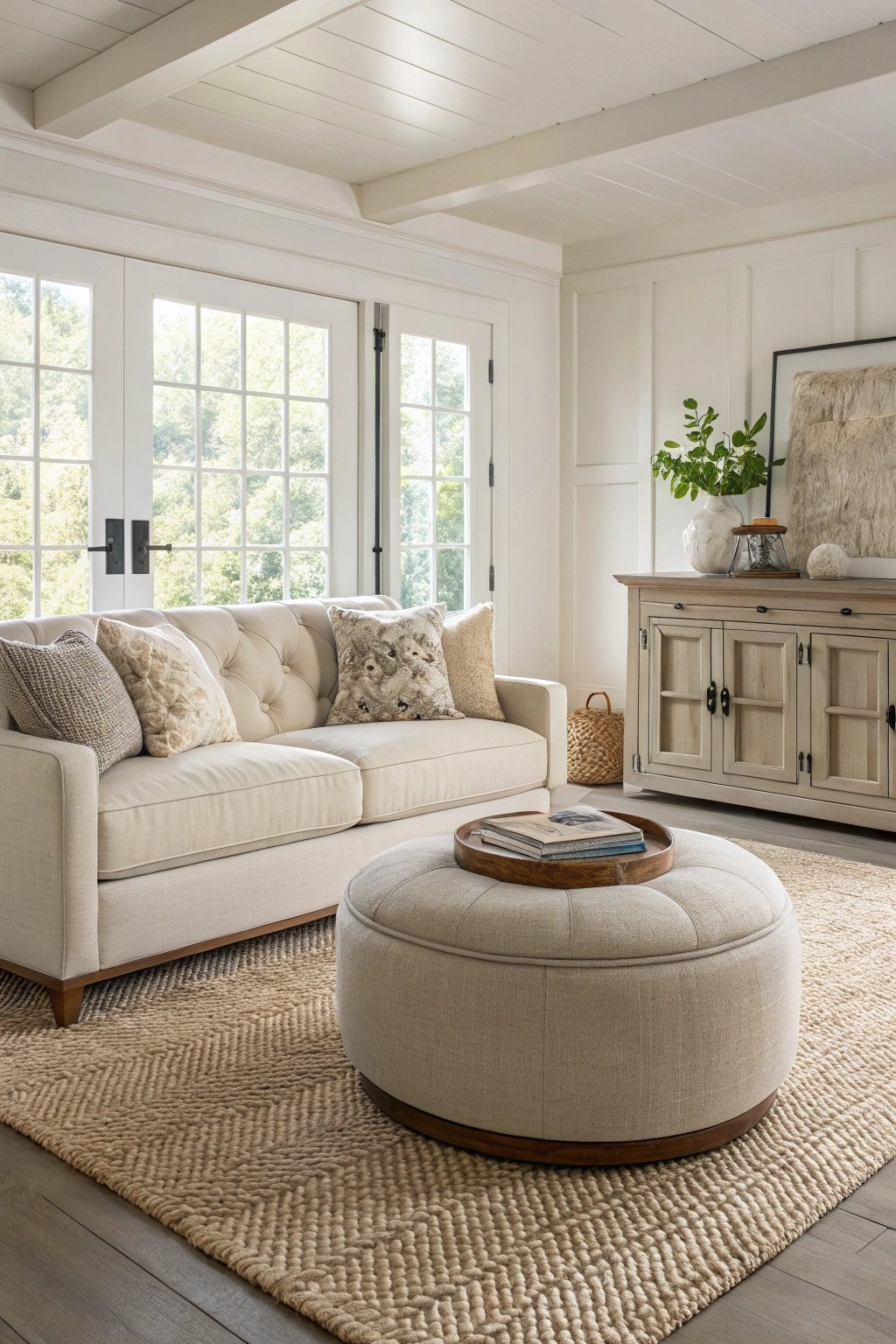
Design for real life without sacrificing style. Performance fabrics resist stains, removable covers simplify washing, and rounded corners ease bumps.
Closed storage swallows toys and remotes, while durable rugs—wool blends or indoor-outdoor fibers—manage spills. The room remains elegant even after everyday chaos.
What makes something unique
Specify zipper-closure cushion covers and modular slipcovers in cohesive tones for easy refresh. Integrate a charging drawer in the console to hide cords.
Choose a washable throw that matches the rug’s undertone so “cleanup” layers look deliberate. Practical details elevate the interior design living room from fragile to formidable.
16) Art-Forward Focus
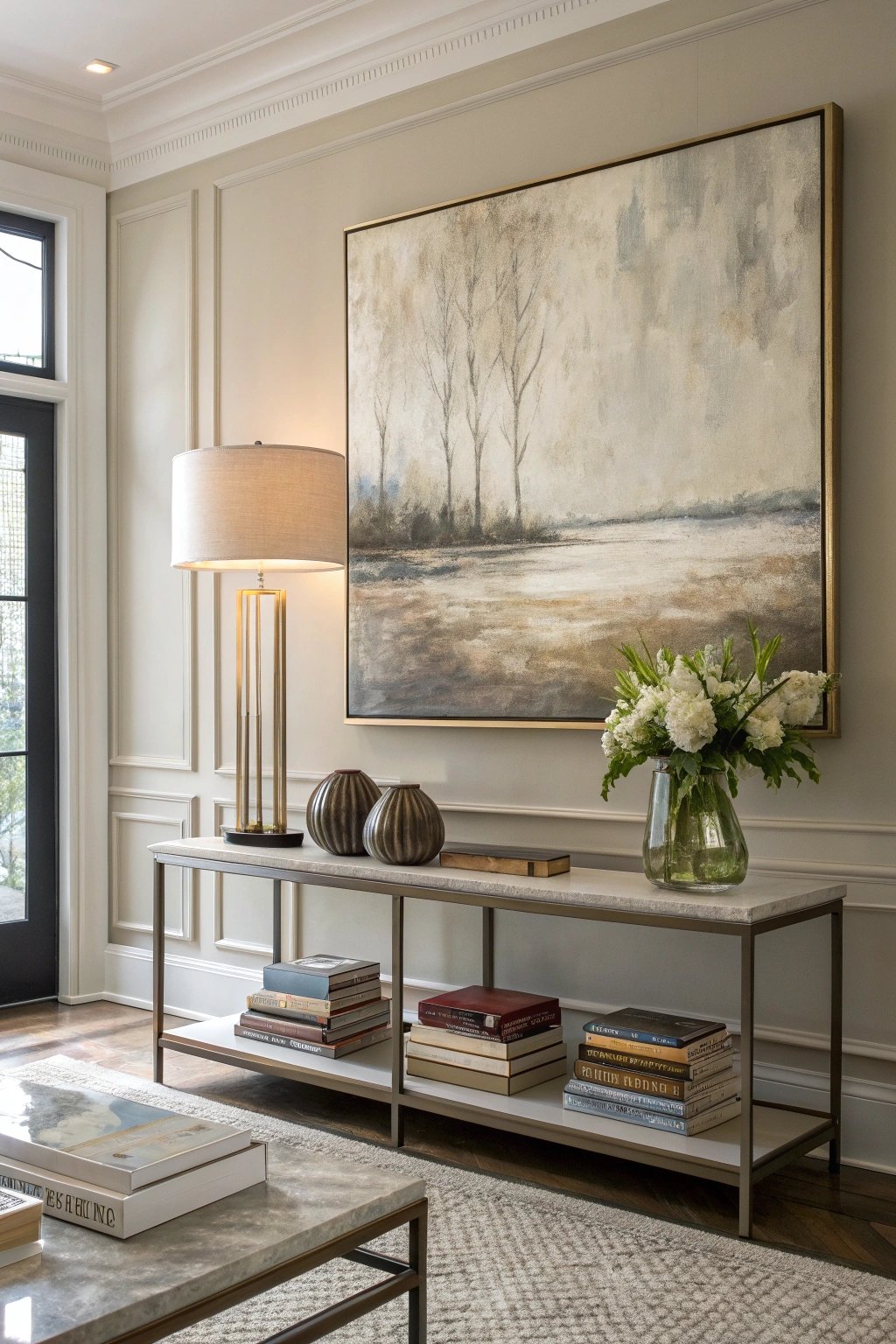
Let art carry narrative. One oversized piece above the sofa or a tight diptych grounds the room. Keep frames slim, finish-matched to hardware.
Negative space around the work allows it to breathe, while a picture light skims texture for evening drama.
What makes something unique
Float-mount deckled paper or fabric inside a deep frame to cast subtle shadows. Pair a heavy object (stone bowl) with a delicate one (glass stem vase) on the coffee table to echo the artwork’s balance. The interior design living room becomes a quiet gallery without feeling precious.
17) Sustainable & Vintage Mix
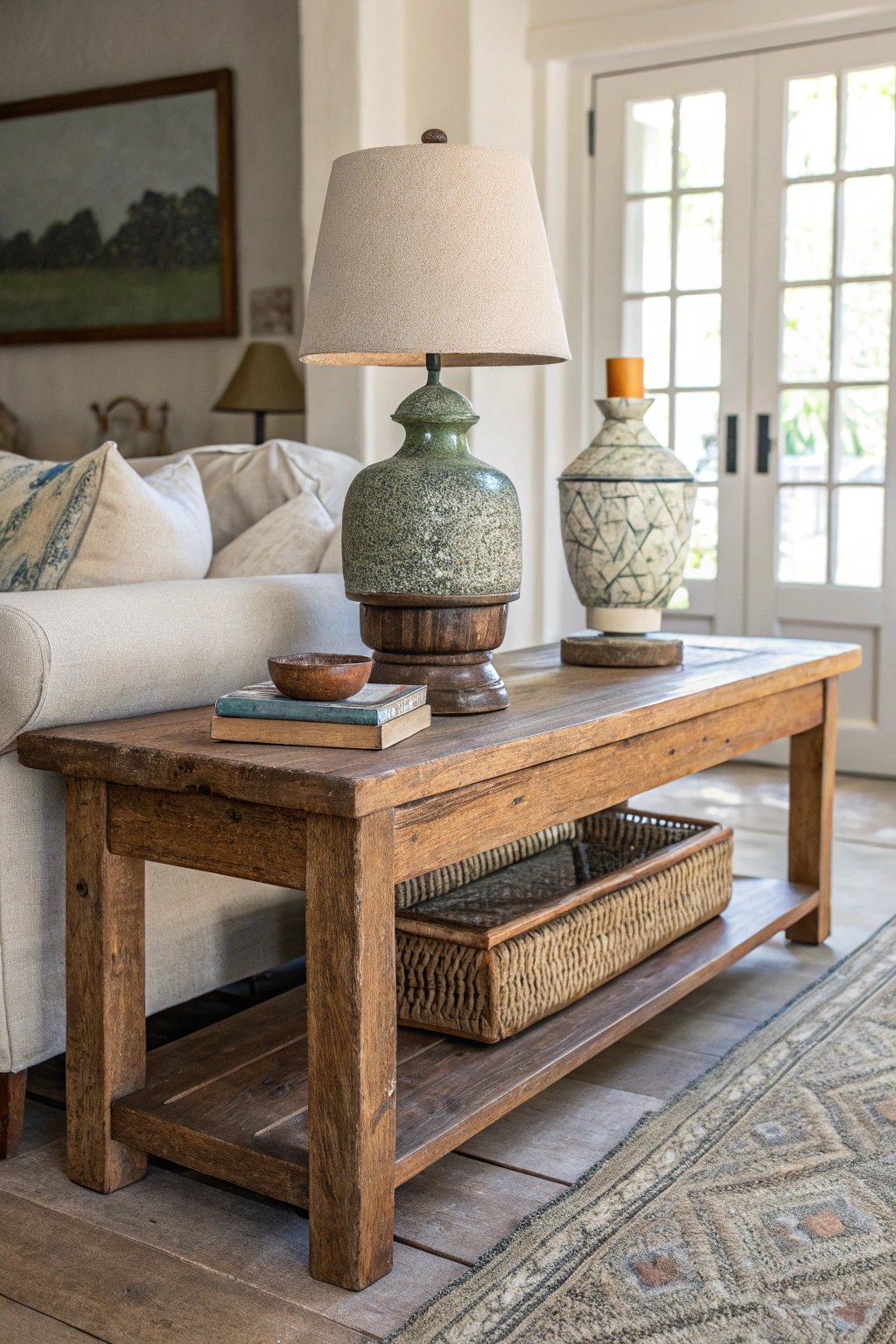
Mindful design adds soul. Blend FSC-certified woods and low-VOC finishes with vintage benches, reupholstered chairs, and artisan ceramics.
Patina reduces the need for perfection, and quality secondhand finds often fit smaller footprints. Sustainability here is not sacrifice; it’s character and longevity.
What makes something unique
Pick a material story—raw oak, aged brass, or stone—and repeat it across frames, pulls, and accessories. Document sources and care so pieces age gracefully.
The layered history turns the interior design living room into a space that feels collected, not consumed.
18) Luxe Minimalism
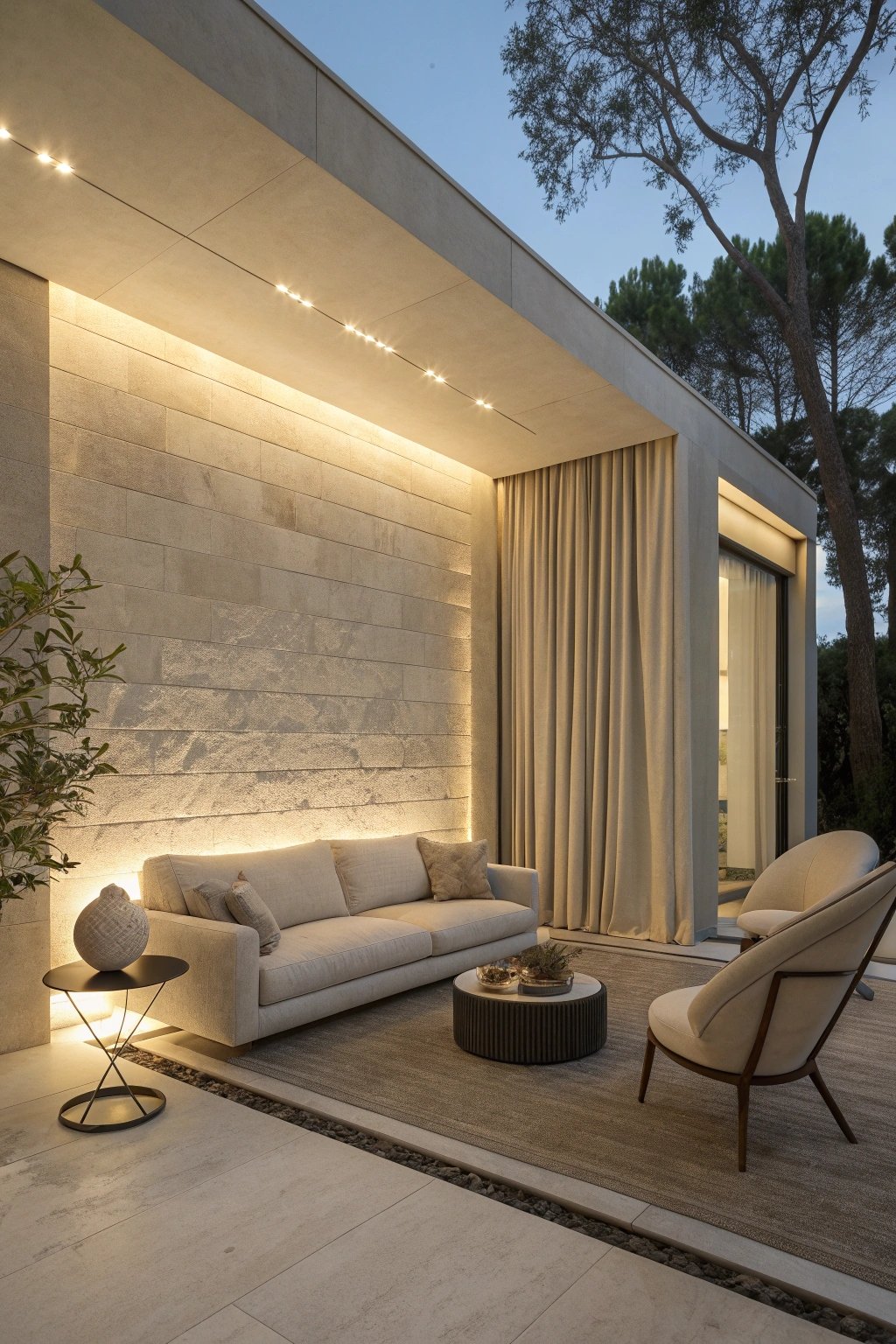
Edit to essentials and amplify quality. Choose fewer, better pieces with impeccable proportion: a tailored sofa, sculptural lounge chair, precise stone table, and a flawless rug.
Cables vanish, surfaces stay clear, and every object earns its place. The calm reads expensive without shouting.
What makes something unique
Use architectural moves for drama: a shadow-gap base under the console, a recessed LED washing textured plaster, and monolithic drapery color-matched to walls.
With proportion and light as heroes, the interior design living room becomes a sanctuary that’s easy to maintain and hard to forget.

